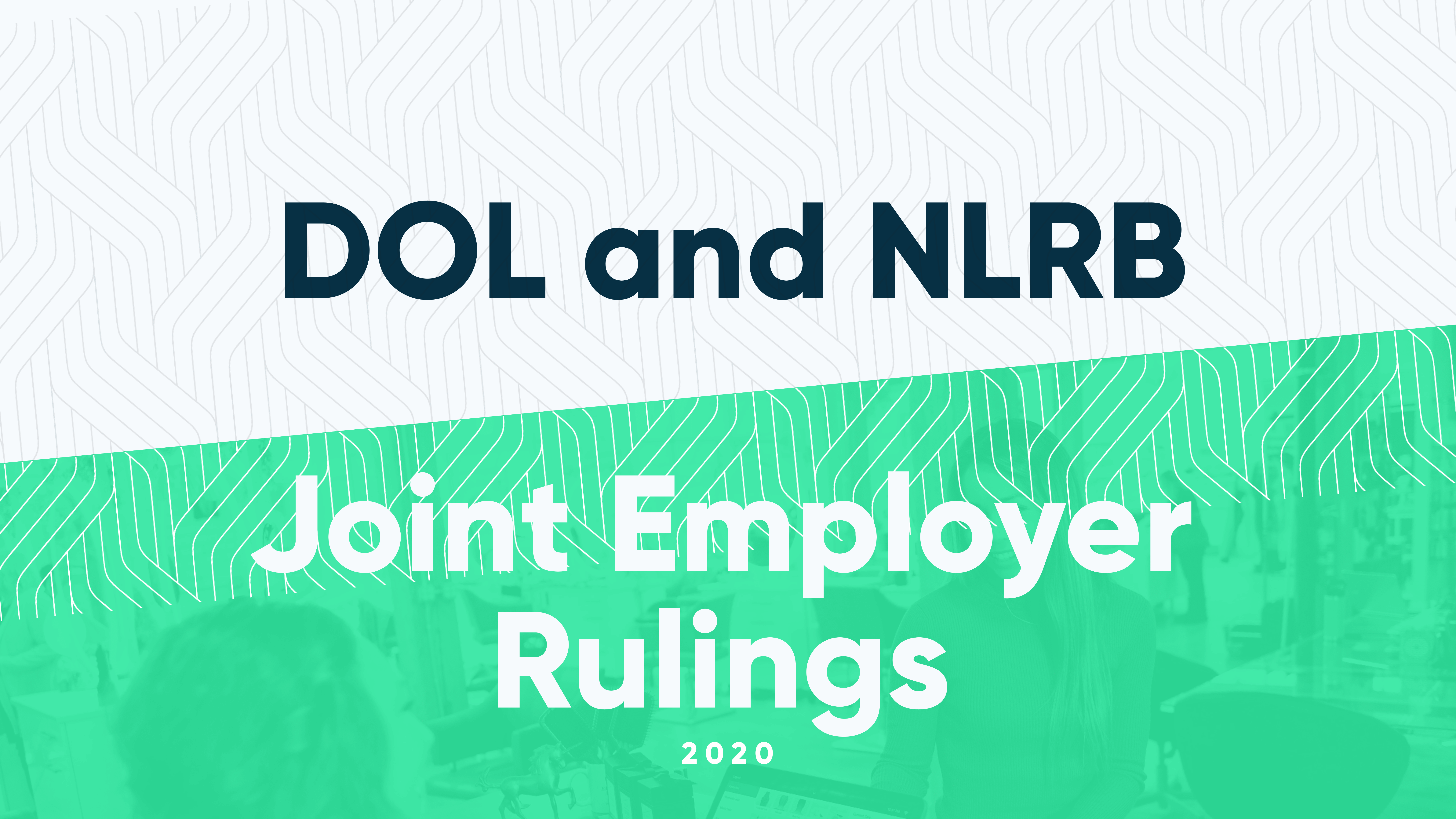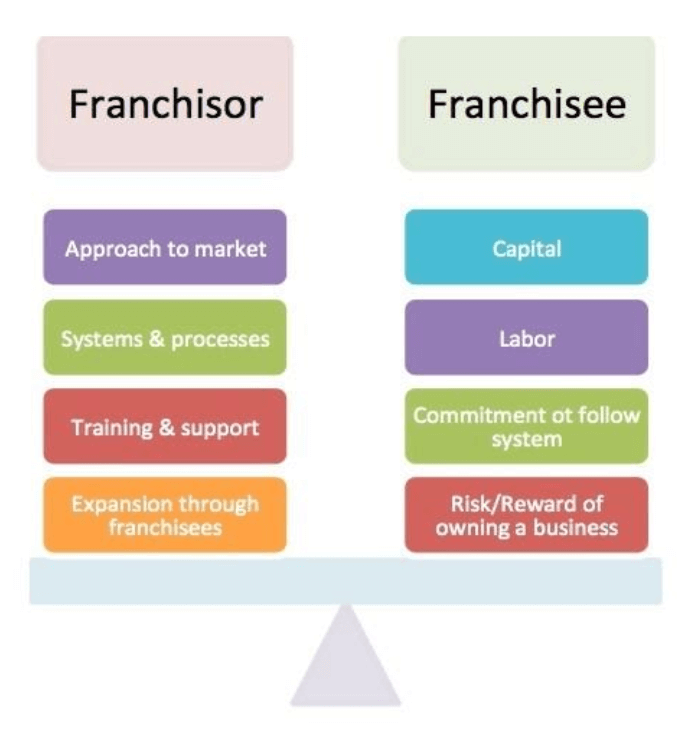The DOL & NLRB “Joint Employer” Rulings Narrow Definitions for Restaurants, Important Shifts in Liability

- By Harri Insider Team | January 21, 2020
While DOL has helped restaurant franchises clear a big obstacle by strictly defining what makes “Joint Employers”, there are still a few big hurdles left for restaurant franchises sustain a successful business model. On September 8th, a federal judge overturned the new definition, creating more difficulty for operators and employees.
Understanding the impact of the joint employer ruling has on the franchises can’t be fully grasped until you understand the relationship between the franchisee and the franchisor.

The Nature of the Franchisor/Franchisee Relationship
When a business needs to grow fast, without using much of its own capital, and limiting its risk the owner may choose to franchise its operations. Acting as a franchisor, an owner seeks ambitious “franchisees” who will “buy” into its brand, creating a partnership. Through mutually-approved contracts, the franchisee agrees to execute operations that are the sole property of the franchisor. As in most cases, the franchisor “sells” franchises, collects royalties, and monitors the franchisees for compliance. That means that the standards, policies, procedures and processes which originate from the franchisor, must be followed by the franchisee or face sanctions not limited to termination of contract, if violations are severe enough. For franchises to be successful, both franchisee and franchisor must be clear on each other roles and responsibilities, then work to support one another. Restaurant franchises are a great example of this.
Employee Perception Becomes Franchise Reality
Part of the success of the restaurant franchise business model hinges on the synergy between the (2) main players: the franchisor and franchisee. Although the franchisee effectively runs the operations publicly, the franchisor is the “face” of the operations with marketing and advertising. So, on the surface it appears that a brand such as McDonald’s is one entity, when in fact it’s made up of more than 36,000 franchises worldwide.
When employees are recruited, hired, and trained they aren’t interested in distinguishing franchisee from franchisor, they generally assume it’s one and the same. As with any business, when employees feel they’ve been wronged, they look to the management team to resolve the issues fast. When restaurant franchises have failed to resolve store level issues, employees seek solutions beyond the store level. Franchisors, unanimously believe lawsuits allowing employees to sue both franchisor and franchisee, threaten the existence of the Franchise Business model. So, a change in the joint employer law must occur to protect the Franchisor, especially one the size of McDonalds, from franchisee-level disputes.
Joint Employer Law Impact
How the joint employer law impacts the restaurant franchise business model is important because it establishes the liability a franchisor has to the employees, if any. In 2016 the NLRB (National Labor Relations Board) broadened the definition of joint employer which favored the employees right to sue both franchisee and franchisor. Franchisors warned that they would likely limit or stop franchising because of such liabilities. Since then, the International Franchise Association (IFA) has argued that the Obama standard increased lawsuits against employers, cost jobs and sapped the American economy of $33.3 billion per year.
With the increased pressure from industries that use contracted labor, temp agencies, as well as the franchise industry itself, the DOL (Department Of Labor) recently adjusted the criteria for designating a “joint employer” only if the franchisor directly:
-
Hires or fires the employee
-
Supervises and controls the employee’s work schedule or conditions of employment to a substantial degree;
-
Determines the employee’s rate and method of payment
-
Maintains the employee’s employment records.
Although these criteria will go into effect within 60 days, the EEOC and state labor laws will need to align rules to comply with federal changes. Current and future Franchisors expect this “4-part test” to reduce the amount of lawsuits initiated by disgruntled employees that potentially slow industry growth. However, the federal judge specifically struck down the section that applies to staffing arrangements by calling it “arbitrary and capricious”.
As the announcement reads from the NLRB, franchisor and franchisee will be considered joint employers “only if the two share or codetermine the employees’ essential terms and conditions of employment,” the NLRB said. Those essential terms and conditions “are exclusively defined as wages, benefits, hours of work, hiring, discharge, discipline, supervision and direction,”
As an industry, the potential to save hundreds of millions of dollars in lawsuits is huge and could provide a boost to the already low unemployment. But now that the DOL has help decide who should be held accountable when employees are mismanaged, it is time focus on to preventing employee lawsuits.
An Ounce of Prevention Is Worth a Pound of Cure
As much as the restaurant and other industries are applauding the recent rulings to strictly define criteria of responsibility to employees, I find it irresponsible that the franchises could have avoided worker law violations, and chose not to act. The most high-profile violations that have occurred has been:
-
Violation of meal breaks and overtime pay
-
Sexual harassment
-
Firing $15 minimum wage participants
-
Lack of employee safety measures
-
Improper scheduling practices
Most lawsuits in the restaurant business can be avoided. Paying out hundreds of millions of dollars to settle employee lawsuits is like taking an aspirin to cure a toothache. The “Joint Employer” ruling may reduce the lawsuits, but as long as the violations continue it only serves to treat the “symptoms” of poor employee relations and not address the root causes. The judge who blocked portions of this rule claims that it goes against the Fair Labors Standards Act (FLSA).
Companies can effectively “cure” their issues by tackling the root causes of worker violations starting with taking direct control over their cultures, to properly train, develop, engage, and retain employees in an ethical way that values them as assets. Then, hold themselves accountable when things go wrong rather, than participating in a defensive, finger-pointing game of pass the buck. Franchisors and franchisees may battle one another over who’s most responsible for the employee experience, but they can’t let the battleground become the workplace, while the employees’ futures hang in the balance.
Take Care of Employees and They Will Take Care of You
Employees are not motivated to sue the franchisor, franchisee, or the whole business model. Employees are only motivated to act in their best interest when they feel their rights are violated. They only want to be treated with respect, feel valued, and work in a secure environment that provides opportunity for growth. When companies put the employees first, the employees reward them with lower turnover, food costs, and high customer satisfaction.
Now more than ever it is important to have a sense of security and clarity, and with this judge’s ruling, that has become more difficult. There is now an air of uncertainty and a higher risk for violations.
The best weapon against the effects of low employee satisfaction is a workforce solution that helps avoid the “pitfalls” of workplace violations. Harri provides best-in-class workforce management technology that initiates, tracks, and completes the necessary steps in the employee process from applicant to team member. Harri takes the guesswork out of wage compliance through its time and attendance application. Another highly-effective feature of Harri is its scheduling platform that will be the key to companies to follow the new Predictive Scheduling Law.




















